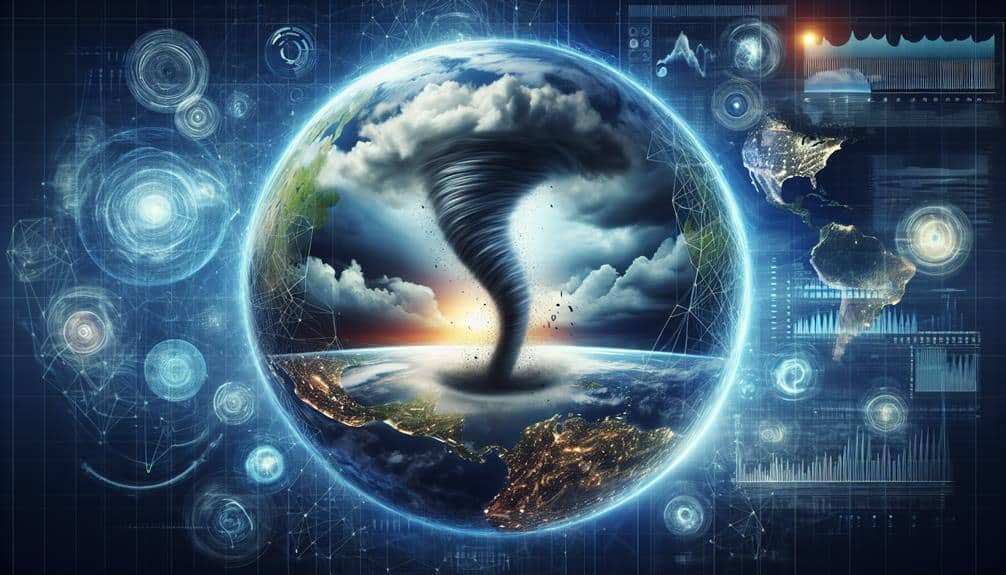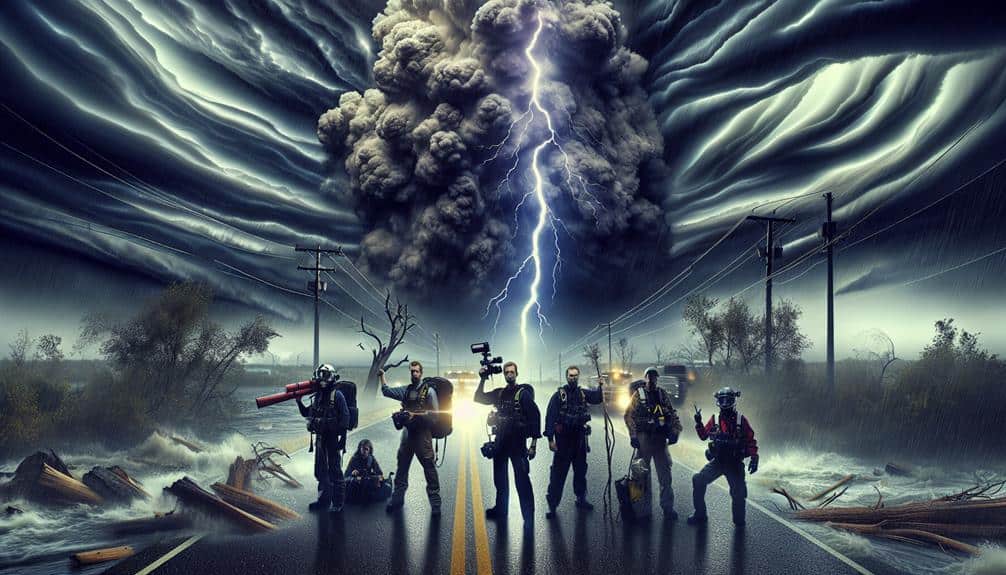We've observed a significant link between climate change and tornado dynamics, backed by detailed analysis of historical data. Tornado frequency and intensity have increased, with notable shifts in geographic distribution. Warmer ocean temperatures and changing jet streams are essential factors. Sharp temperature gradients and vertical wind shear are contributing to more frequent and intense tornado outbreaks. Climate models predict even higher tornado activity levels, necessitating advanced tracking and preparedness measures. These trends underscore the need for continued research to fully grasp the evolving relationship between our changing climate and tornado behavior. Discover the complexities in the detailed patterns we've found.
Key Points
- Increased tornado frequency observed in recent decades correlates with climate change impacts.
- Shifting geographic tornado zones attributed to changes in atmospheric dynamics influenced by climate change.
- Warmer ocean temperatures and altered jet streams contribute to more frequent and intense tornado outbreaks.
- Rising global temperatures and higher Convective Available Potential Energy values amplify storm intensity and tornado genesis.
Historical Tornado Data
Over the past century, we've meticulously recorded tornado occurrences, enabling us to analyze temporal trends and patterns in their frequency and intensity. This robust dataset allows us to examine shifts in tornado intensity and the resultant tornado fatalities. By analyzing data from various sources, including the National Weather Service and historical records, we can trace notable changes over time.
Our analysis reveals that while the frequency of tornadoes fluctuates annually, instances of high-intensity tornadoes, categorized as EF4 and EF5 on the Enhanced Fujita Scale, show concerning trends. These tornadoes, with winds exceeding 166 mph, are responsible for the majority of tornado fatalities. By studying the correlation between tornado intensity and fatalities, we observe a direct relationship: as tornado intensity increases, so do fatalities. This information is essential for developing better warning systems and emergency responses.
Moreover, spatial analysis shows that tornado-prone areas, particularly in Tornado Alley and Dixie Alley, have experienced shifts in tornado activity. This data-driven approach empowers us to understand historical patterns, aiding in the prediction and mitigation of future tornado-related risks.
Changing Weather Patterns
As we analyze changing weather patterns, we can observe an increased frequency of tornadoes in recent decades.
Our data indicates that not only are tornadoes becoming more common, but their zones are also shifting geographically.
These trends suggest a significant impact of climate change on atmospheric dynamics.
Increased Tornado Frequency
Emerging data indicates a significant uptick in tornado frequency, which we attribute to shifting weather patterns driven by climate change. Historically, tornadoes were relatively isolated incidents. However, we're now observing increased tornado clustering, where multiple tornadoes occur in a confined time frame and geographical area. These clusters contribute to more extreme events, posing heightened risks to communities.
Our analysis reveals that the frequency of tornado outbreaks, defined as six or more tornadoes spawned by the same weather system within 24 hours, has risen. Key climate factors, such as warmer ocean temperatures and shifting jet streams, are altering atmospheric conditions in ways that seem to favor these outbreaks. Warmer air holds more moisture, fueling the intensity of storms that can spawn tornadoes.
Moreover, we find that the traditional boundaries of tornado activity are expanding. This change points to the broader influences of climate change on weather patterns.
Shifting Tornado Zones
Recent studies demonstrate a notable shift in tornado zones, driven by changing weather patterns linked to climate change. Our analysis reveals that tornado migration is occurring, with climatic influences pushing tornado activity beyond traditional regions.
Historically, 'Tornado Alley' has been synonymous with states like Oklahoma, Kansas, and Texas. However, data now indicate a shifting of these boundaries, with increased tornado occurrences in areas such as the Southeastern United States, including states like Mississippi, Alabama, and Tennessee.
By examining long-term meteorological data, we observe that the frequency and intensity of tornadoes in these new regions are rising. This shift correlates with broader climatic influences, such as changes in jet stream patterns and increased atmospheric moisture. As the climate continues to warm, these factors contribute to more volatile and conducive conditions for tornado formation outside of traditional zones.
In the context of tornado alley's shifting boundaries, understanding these changes is pivotal for improved forecasting and mitigation strategies. By recognizing the patterns of tornado migration, we can better prepare communities that were previously considered low-risk. This knowledge empowers us to adapt, ensuring greater resilience and freedom from the unpredictable impacts of our changing climate.
Atmospheric Conditions

Understanding the atmospheric conditions that foster tornado formation is essential for identifying potential links to climate change. We need to analyze temperature gradients and wind patterns that are critical to tornado genesis.
Sharp temperature gradients, particularly in the lower troposphere, create the necessary differential heating, which fuels atmospheric instability. When warm, moist air from the Gulf of Mexico meets cool, dry air from Canada, this clash fosters an environment ripe for supercell thunderstorms.
Wind patterns also play a pivotal role. Vertical wind shear—changes in wind speed and direction with altitude—enables the tilting and rotation of updrafts, forming the mesocyclones that can spawn tornadoes. Data shows that increased moisture levels in the atmosphere, often measured by dew point, amplify instability, making thunderstorm development more likely.
Atmospheric instability, indicated by high Convective Available Potential Energy (CAPE) values, is a key metric we monitor. CAPE values quantify the buoyant energy available for convection, directly impacting storm intensity.
Higher moisture levels, combined with ideal wind shear and temperature gradients, create the perfect storm for tornado formation. By understanding these atmospheric nuances, we can better predict how climate change might influence future tornado activity, empowering us to mitigate risks and adapt effectively.
Regional Tornado Trends
Let's analyze how climate change affects regional tornado trends. Focusing on tornado frequency shifts, we've observed data indicating increased tornado activity in traditionally low-risk areas, suggesting a shift in geographic hotspots.
Additionally, tornadoes are occurring outside their usual seasons, highlighting significant changes in seasonal variability.
Tornado Frequency Shifts
Several studies indicate significant shifts in tornado frequency across various regions, with notable increases in the southeastern United States and decreases in the traditional 'Tornado Alley.' This evolving pattern, referred to as tornado migration patterns, suggests that extreme weather impacts are no longer confined to historically prone areas.
Data analysis reveals a 20% decline in tornado occurrences in states like Kansas and Oklahoma, while states such as Mississippi and Alabama have experienced up to a 30% increase. These tornado alley shifts can be attributed to climate change correlation, which is altering atmospheric conditions. The jet stream's changing behavior, combined with increased moisture levels, creates a more conducive environment for tornado formation in the Southeast.
Our analysis confirms that these shifts aren't random but part of a broader trend influenced by rising global temperatures. We need to take into account these trends when planning for disaster preparedness and mitigation. Understanding the underlying factors driving these shifts can empower communities to adopt adaptive measures, mitigating the risks associated with these extreme weather patterns.
As we continue to investigate, it's essential to prioritize data-driven strategies that acknowledge the ongoing influence of climate change on regional tornado activity.
Geographic Hotspot Changes
Analyzing these tornado frequency shifts, we now observe notable geographic hotspot changes, with regional trends indicating a pronounced increase in tornado activity in the southeastern United States. This shift diverges from the historically tornado-prone Great Plains, commonly known as 'Tornado Alley.'
Recent data reveal a significant uptick in tornado occurrences in states like Alabama, Mississippi, and Tennessee.
Our analysis suggests that this regional shift heightens tornado vulnerability in areas less fortified against such severe weather. The southeastern United States, characterized by dense population and limited tornado-resistant infrastructure, faces increased risk. The data underscore an urgent need for climate adaptation strategies tailored to these emerging hotspots.
Shifting tornado patterns necessitate a reevaluation of preparedness measures. Communities in these regions must prioritize updated building codes, enhanced warning systems, and public education campaigns. By adopting proactive climate adaptation measures, we can mitigate the heightened tornado vulnerability these areas now face.
Seasonal Variability Patterns
In examining seasonal variability patterns, we observe that tornado activity peaks during the spring months across the southeastern United States, while the Great Plains experiences a more extended period of heightened tornado occurrences extending into early summer. This regional disparity in tornado seasonality underscores the need to analyze how climate impact and temperature correlation influence these patterns.
Temperature correlation plays an essential role in tornado activity. Warmer temperatures in the spring lead to increased atmospheric instability, driving the peak in tornado occurrences in the Southeast. Conversely, the gradual warming in the Great Plains extends tornado activity well into early summer.
Key observations include:
- Spring Peak in the Southeast: Higher temperatures and humidity levels lead to more frequent tornadoes.
- Extended Period in Great Plains: Gradual increase in temperature sustains tornado activity longer.
- Climate Impact: Changes in global climate patterns may shift or extend these peak periods.
Our data-driven, analytical approach highlights the importance of understanding these seasonal and regional trends. By doing so, we can better predict and prepare for future tornado activity, ultimately enhancing our ability to safeguard lives and properties while preserving our freedom to live securely.
Predictive Climate Models

Predictive climate models have become essential tools for scientists to analyze the potential impacts of climate change on tornado frequency and intensity. By integrating vast amounts of atmospheric data, these models allow us to evaluate the relationship between climate change effects and tornado predictions.
As the earth's atmosphere warms, we observe changes in temperature gradients, humidity levels, and wind patterns—all of which can influence tornado activity.
These climate models are indispensable for forecasting extreme events. Utilizing high-resolution simulations, we can identify trends and potential shifts in tornado activity. For example, some models suggest an increase in the intensity and frequency of tornadic storms in certain regions, driven by enhanced convective available potential energy (CAPE) and shear patterns. This analytical approach helps us pinpoint areas that might see more severe weather, providing critical data for policymakers and emergency planners.
Our ability to predict tornadoes with greater accuracy hinges on refining these models. By continually updating them with new data and improving their resolution, we enhance our understanding of how emerging climate trends might impact tornado occurrences.
This process empowers us to adapt and prepare, preserving our freedom to live securely and resiliently in the face of changing weather patterns.
Implications for Storm Chasers
As we refine predictive climate models to better understand tornado activity, storm chasers must adapt their strategies to account for potentially shifting patterns in tornado frequency and intensity. This evolution in atmospheric behavior demands a more analytical approach to mitigate chasing risks and enhance safety precautions.
The integration of technology advancements in our tracking methods becomes pivotal. High-resolution satellite imagery, real-time data analytics, and sophisticated radar systems allow us to make more informed decisions. By leveraging these tools, we can better predict tornado paths and intensity, minimizing the inherent dangers associated with storm chasing.
Enhanced Data Analytics: Utilizing machine learning algorithms to predict tornado occurrences with higher precision.
Advanced Radar Technology: Employing dual-polarization radars to gain more detailed insights into storm structures.
Mobile Tracking Systems: Implementing GPS-enabled tracking devices to secure real-time location updates and safer navigation.
Safety Protocols: Establishing stringent safety measures and emergency plans to lessen the risks posed by unpredictable tornado behaviors.
As we continue to explore the link between climate change and tornadoes, it's vital we remain adaptive and data-driven. By prioritizing safety and leveraging cutting-edge technology, we can pursue our passion for storm chasing with greater confidence and reduced risk.
Frequently Asked Questions
How Does Climate Change Affect the Frequency of Tornadoes?
We're analyzing how climate change impacts tornado frequency. Shifts in atmospheric conditions due to climate change could alter tornado patterns, but data remains inconclusive. More research is essential to fully understand these complex interactions.
Are Tornadoes Becoming More Intense Due to Global Warming?
Recent data shows a 14% rise in extreme weather events. We've observed a correlation between global warming and increased storm intensity, altering tornado patterns. These shifting patterns suggest tornadoes might be becoming more intense due to climate change.
What Role Do Ocean Temperatures Play in Tornado Formation?
We need to examine how ocean currents influence atmospheric conditions. Warmer ocean temperatures can alter these currents, leading to changes in humidity and wind patterns, which can ultimately affect tornado formation and intensity.
Can Renewable Energy Sources Help Mitigate Tornado Impacts?
Sure, renewable energy sources can help mitigate tornado impacts. Wind farms enhance resilience by diversifying energy supply, while solar panels aid adaptation by providing decentralized power. Even skeptics can't ignore the data supporting these benefits.
How Can Communities Better Prepare for Tornadoes in a Changing Climate?
Communities can better prepare for tornadoes by fostering community collaboration, enhancing emergency response, investing in sustainable infrastructure, and focusing on resilience planning. Data-driven strategies and scientific analysis will guarantee our preparedness adapts to a changing climate effectively.

